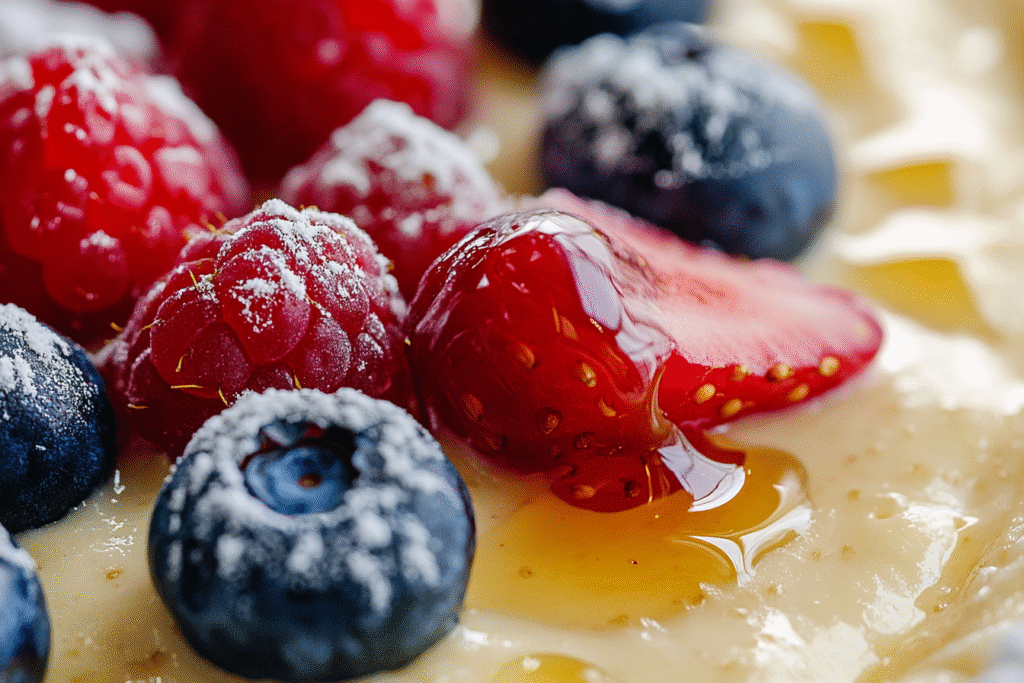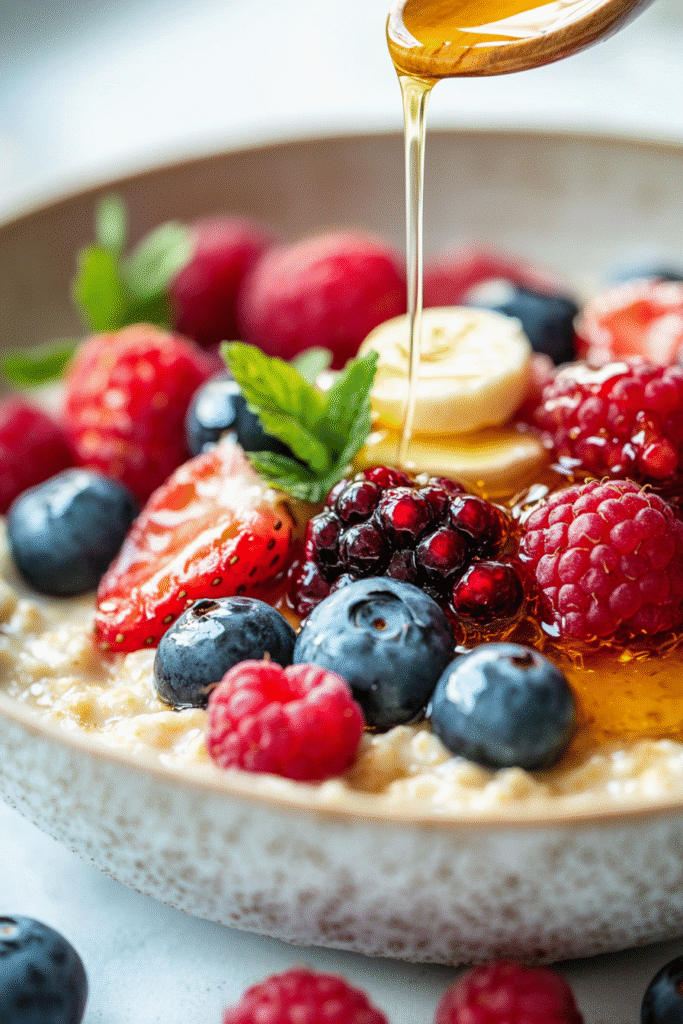Introduction
The Oatmeal Custard Breakfast is a comforting, creamy, and protein-rich twist on your standard bowl of oats. It blends the wholesome goodness of traditional oatmeal with the silky richness of a light custard, creating a breakfast that’s both indulgent and nourishing. Imagine tender oats enveloped in a velvety, softly sweet custard that’s gently cooked until just set—perfectly spoonable and deeply satisfying.
This dish feels almost like a breakfast dessert, yet it’s packed with the sustained energy of oats and the satiating power of eggs and milk. It’s excellent for those who crave a cozy, mildly sweet breakfast that feels elevated but isn’t complicated. Plus, it’s fully customizable: you can dress it up with fruits, nuts, spices, or even a caramelized sugar topping if you’re leaning into the dessert-for-breakfast vibe.
Although the concept is simple, it’s easy to encounter a few challenges like curdled custard, overly thick oats, or bland flavors. This comprehensive guide will walk you through ingredient selection, the right cooking methods, step-by-step instructions, troubleshooting, storage, and creative variations. Whether you’re making it for a slow weekend morning or batch-prepping for the week ahead, this recipe will become a breakfast staple.

What is Oatmeal Custard Breakfast?
Oatmeal Custard Breakfast combines two classic elements:
- Oats for texture, fiber, and slow-releasing energy.
- Egg-based custard for creaminess, protein, and a rich mouthfeel.
Unlike stovetop oatmeal, where milk or water simply cooks the oats, here the oats are gently baked or simmered in a custard base, creating a luscious texture akin to rice pudding or baked custard. It’s a more indulgent way to enjoy oats while still being nutritious and surprisingly filling.

Common Pitfalls and How to Avoid Them
- Curdled Custard: The most common mistake happens when the custard base cooks too quickly, scrambling the eggs. To prevent this, always cook the mixture gently over low heat or bake it in a water bath.
- Overcooked Oats: Quick oats can become too mushy and lose texture in this recipe. Old-fashioned rolled oats are the best choice for maintaining a pleasant bite.
- Too Thick or Dry: If baked too long, the custard can over-set, resulting in a dry texture. Watch baking times carefully and check for a gentle wobble in the center.
- Bland Flavor: Oats can be neutral on their own, so seasoning with a touch of vanilla, cinnamon, or nutmeg—and adding a bit of sweetener—makes all the difference.
Choosing the Right Ingredients
- Oats: Old-fashioned rolled oats are ideal for this recipe. Steel-cut oats require longer cooking times and quick oats can turn mushy.
- Milk: Whole milk offers the creamiest custard. You can substitute with almond, oat, or soy milk, but dairy milk provides the best texture and richness.
- Eggs: Large eggs are the key to creating the custard base. Make sure they’re fresh and properly whisked.
- Sweetener: Brown sugar, maple syrup, or honey work beautifully to lightly sweeten the custard without overpowering the oats.
- Flavorings: Vanilla extract, ground cinnamon, nutmeg, and a pinch of salt enhance the overall depth and make the dish feel cozy and well-rounded.
Equipment Recommendations
- Saucepan or Baking Dish: Depending on whether you’re stovetop cooking or baking the custard.
- Mixing Bowls: For whisking the custard mixture thoroughly before combining with the oats.
- Whisk: Essential for blending the eggs and milk smoothly.
- Ramekins or Small Baking Dish: If baking individual portions.
- Oven-safe Dish (if baking): A water bath is recommended for even, gentle heat.
Cooking Methods: Stovetop vs. Baked
- Stovetop Method: Faster and results in a creamier, pudding-like texture. This is great for weekday mornings.
- Baked Method: Offers a firmer custard, almost like a breakfast crème brûlée. This is excellent for weekend brunches or batch prepping.
Both methods yield delicious results, and the choice comes down to your preferred texture and available time.
Preparation Tips
- Temper the Eggs: Slowly adding a bit of warm milk to the whisked eggs helps prevent curdling when the custard is heated.
- Control the Heat: Whether on the stove or in the oven, low and slow cooking preserves the smoothness of the custard.
- Pre-soak the Oats: For an extra creamy result, you can soak oats in milk for 30 minutes before combining with the custard base.
- Optional Water Bath (for Baking): Placing the baking dish in a larger pan filled with hot water helps regulate oven heat and prevents cracking or overcooking.
Flavor Additions and Toppings
- Fresh Fruits: Berries, banana slices, baked apples, or poached pears.
- Nuts: Toasted almonds, walnuts, or pecans add crunch.
- Spices: Cinnamon, nutmeg, cardamom, or even ginger for a warm spice profile.
- Sweet Toppings: Maple syrup, honey drizzle, brown sugar, or even a torched sugar top for a crème brûlée effect.
- Savory Option: Reduce or omit sugar and add cheese, sautéed spinach, or herbs for a savory custard oat bake.
Dietary Substitutions
- Dairy-Free: Use plant-based milk (almond, oat, soy) and ensure you use oil or plant-based butter if greasing baking dishes.
- Gluten-Free: Rolled oats are naturally gluten-free but check for certified gluten-free oats to avoid cross-contamination.
- Sugar-Free: Substitute with monk fruit sweetener, erythritol, or simply omit added sweeteners and rely on fruit for natural sweetness.
- Egg-Free: For a non-custard variation, use cornstarch and plant-based milk to create a pudding-like texture, though it won’t be a true custard.
Ingredients
For the Custard Oatmeal
- 1 cup (90g) old-fashioned rolled oats
- 2 large eggs
- 2 cups (480ml) whole milk (or plant-based milk)
- 2 tablespoons brown sugar, maple syrup, or honey
- 1 teaspoon vanilla extract
- 1/2 teaspoon ground cinnamon (optional)
- 1/4 teaspoon salt
Optional Toppings
- Fresh berries
- Banana slices
- Toasted nuts
- Maple syrup or honey drizzle
- Brown sugar (for broiled sugar topping)
Step-by-Step Instructions
Stovetop Method
1. Prepare the Custard Mixture
- In a medium bowl, whisk together eggs, milk, sweetener, vanilla extract, cinnamon, and salt until smooth.
2. Cook the Oats
- In a medium saucepan, bring the custard mixture to medium-low heat.
- Stir constantly until the mixture is warm but not boiling.
- Stir in the oats.
3. Simmer Gently
- Cook over low heat for 8–10 minutes, stirring frequently, until the oats are tender and the custard has thickened to a creamy consistency.
4. Serve
- Transfer to bowls, top with desired fruits, nuts, and sweeteners, and serve warm.
Baked Method
1. Preheat the Oven
- Preheat oven to 325°F (160°C).
2. Prepare the Custard Mixture
- Whisk eggs, milk, sweetener, vanilla extract, cinnamon, and salt in a mixing bowl.
3. Combine with Oats
- Stir in the oats and let sit for 5 minutes to start softening.
4. Pour into Baking Dish
- Lightly grease a small baking dish or ramekins.
- Pour the custard oatmeal mixture into the dish(es).
5. Optional Water Bath
- Place the dish(es) in a larger roasting pan.
- Pour hot water into the outer pan until it comes halfway up the sides of the baking dish to ensure gentle, even cooking.
6. Bake
- Bake for 30–35 minutes or until the custard is set but still slightly wobbly in the center.
7. Cool Briefly and Serve
- Allow to cool for 5–10 minutes before serving.
- Top with fruit, nuts, and a drizzle of maple syrup or a sprinkle of brown sugar.
Troubleshooting Tips
- Custard Curdled: Keep the heat low and stir constantly if cooking on the stove. If baking, use a water bath to control temperature.
- Too Runny: The custard may not have fully set; extend cooking or baking time by a few minutes.
- Too Thick: Reduce the cooking time slightly next time or add a splash of milk to loosen it when serving.
Storage and Reheating
- Storage: Store leftovers in an airtight container in the refrigerator for up to 4 days.
- Reheating: Warm individual portions in the microwave for 1–2 minutes, stirring halfway through, or heat gently on the stovetop with a splash of milk to restore creaminess.
Serving Suggestions
- Sweet Style: Top with fresh berries, banana slices, a drizzle of maple syrup, and a sprinkle of cinnamon.
- Decadent: Sprinkle with brown sugar and briefly broil to create a caramelized, crackly top.
- Savory Option: Omit the sweetener and cinnamon, top with sautéed mushrooms, grated cheese, and herbs for a savory custard oatmeal.
- Brunch Spread: Serve as a cozy side dish alongside fresh fruit, scones, and coffee for a comforting breakfast table.
Comparison: Traditional Oatmeal vs. Custard Oatmeal
| Feature | Traditional Oatmeal | Oatmeal Custard Breakfast |
|---|---|---|
| Cooking Time | Faster (5–10 min) | Slightly longer (10–35 min) |
| Texture | Creamy but thinner | Rich, silky, more pudding-like |
| Protein Content | Lower | Higher due to eggs and milk |
| Flavor Depth | Mild | More complex and custardy |
| Meal Satisfaction | Good | More filling and luxurious |
The Oatmeal Custard Breakfast bridges the gap between nutritious and indulgent, offering a more satisfying, elevated alternative to the usual bowl of oats.
